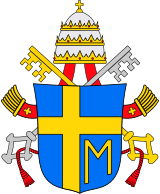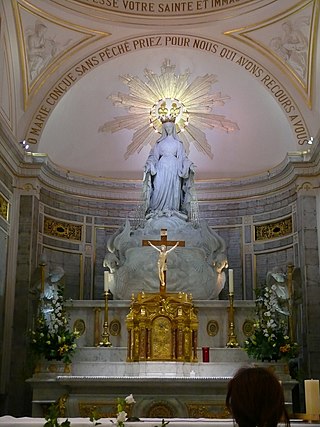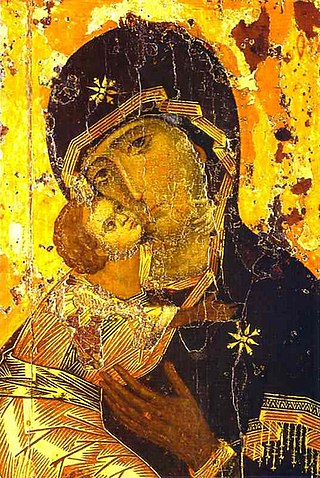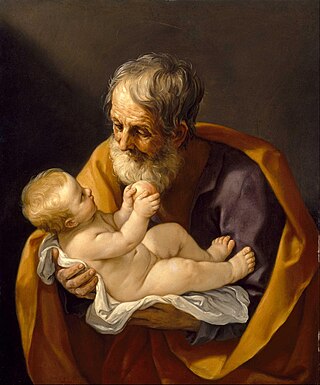
A Marian Cross is a term to describe a symbolic representation of the close connection of Mary, with the redemptive mission of Jesus. The letter "M" below the cross indicates Mary's presence at the foot of the cross.

A Marian Cross is a term to describe a symbolic representation of the close connection of Mary, with the redemptive mission of Jesus. The letter "M" below the cross indicates Mary's presence at the foot of the cross.
The combination of the letter M with a Latin cross is found as part of the 1830 design of the Miraculous Medal (also known as the Medal of Our Lady of Graces based on Saint Catherine Labouré revelations). In that design the letter M is surmounted by a normal Latin cross standing on a bar interlaced with the letter M. [1] [2]

The papal coat of arms of John Paul II features a cross shifted away from its usual central position to make room for a letter "M" in the sinister base quarter (lower right as seen by the viewer), which represents the Virgin Mary’s presence at Jesus’ death on the cross. [3]
In a 1978 article, Vatican newspaper, L'Osservatore Romano , reported:
The coat of arms for Pope John Paul II is intended to be a homage to the central mystery of Christianity, that of Redemption. It mainly represents a cross, whose form however does not correspond to any of the usual heraldry models. The reason for the unusual shift of the vertical part of the cross is striking, if one considers the second object included in the Coat of Arms: the large and majestic capital M, which recalls the presence of the Madonna under the Cross and Her exceptional participation in Redemption. The Pontiff’s intense devotion to the Holy Virgin is manifested in this manner. [4]
John Paul wrote: "As is well-known, in my episcopal arms, which are a symbolic illustration of the gospel text John 19:25-27." [5] ("Standing by the cross of Jesus were his mother and his mother's sister, Mary the wife of Clopas, and Mary of Magdala. When Jesus saw his mother and the disciple there whom he loved, he said to his mother, 'Woman, behold, your son.' Then he said to the disciple, 'Behold, your mother.'") [6]
Papal coats of arms are the personal coat of arms of popes of the Catholic Church. These have been a tradition since the Late Middle Ages, and has displayed his own, initially that of his family, and thus not unique to himself alone, but in some cases composed by him with symbols referring to his past or his aspirations. This personal coat of arms coexists with that of the Holy See.

Catholic Mariology is Mariology in Catholic theology. According to the Immaculate Conception taught by the Catholic Church, she was conceived and born without sin, hence Mary is seen as having a singular dignity above the saints, receiving a higher level of veneration than all angelic spirits and blessed souls in heaven. Catholic Mariology thus studies not only her life but also the veneration of her in daily life, prayer, hymns, art, music, and architecture in modern and ancient Christianity throughout the ages.

The Immaculate Heart of Mary is a Roman Catholic devotional name used to refer to the Catholic view of the interior life of Mary, mother of Jesus, her joys and sorrows, her virtues and hidden perfections, and, above all, her virginal love for God the Father, her maternal love for her son Jesus Christ, and her motherly and compassionate love for all mankind. Traditionally, the Immaculate Heart is depicted pierced with seven swords or wounds, in homage to the seven dolors of Mary and roses, usually red or white, wrapped around the heart.

The Miraculous Medal, also known as the Medal of Our Lady of Graces, is a devotional medal, the design of which was originated by Catherine Labouré following her apparitions of the Blessed Virgin Mary in the Chapel of Our Lady of the Miraculous Medal of Paris, France. It was made by goldsmith Adrien Vachette.

The Chapel of Graces of the Miraculous Virgin or informally the Chapel of Our Lady of the Miraculous Medal, is a Marian pontifical shrine located in Paris, France.
Co-Redemptrix is a title used by some Catholics for the Blessed Virgin Mary, and refers to Mary's role in the redemption of all peoples.

Our Lady of Confidence, also known as La Madonna della Fiducia or Our Lady of Trust, is a venerated image of the Blessed Virgin Mary enshrined at the Lateran Basilica. The feast of Our Lady of Confidence falls on the last Saturday prior to Lent.

Mary, the mother of Jesus in Christianity, is known by many different titles, epithets, invocations, and several names associated with places.

Mediatrix is a title given to Mary, mother of Jesus in Christianity. It refers to the intercessory role of the Blessed Virgin Mary as a mediator in the salvific redemption by her son Jesus Christ and that he bestows graces through her. Mediatrix is an ancient title that has been used by many saints since at least the 5th century. Its use grew during the Middle Ages and reached its height in the writings of saints Louis de Montfort and Alphonsus Liguori in the 18th century.

Rosarium Virginis Mariae is an apostolic letter by Pope John Paul II, issued on October 16, 2002, which declared from October 2002 to October 2003 as the "Year of the Rosary". It was published by Pope John Paul II in 2002 at the beginning of the twenty-fifth year of his pontificate.

Mariology is the theological study of Mary, the mother of Jesus. Mariology seeks to relate doctrine or dogma about Mary to other doctrines of the faith, such as those concerning Jesus and notions about redemption, intercession and grace. Christian Mariology aims to place the role of the historic Mary in the context of scripture, tradition and the teachings of the Church on Mary. In terms of social history, Mariology may be broadly defined as the study of devotion to and thinking about Mary throughout the history of Christianity.

The history of Catholic Mariology traces theological developments and views regarding Mary from the early Church to the 21st century. Mariology is a mainly Catholic ecclesiological study within theology, which centers on the relation of Mary, the Mother of God, and the Church. Theologically, it not only deals with her life but with her veneration in life and prayer, in art, music, and architecture, from ancient Christianity to modern times.

Throughout history, Catholic Mariology has been influenced by a number of saints who have attested to the central role of Mary in God's plan of salvation. The analysis of Early Church Fathers continues to be reflected in modern encyclicals. Irenaeus vigorously defended the title of "Theotokos" or Mother of God. The views of Anthony of Padua, Robert Bellarmine and others supported the doctrine of the Immaculate Conception of the Virgin Mary, which was declared a dogma in 1850.

The Mariology of the popes is the theological study of the influence that the popes have had on the development, formulation and transformation of the Roman Catholic Church's doctrines and devotions relating to the Blessed Virgin Mary.

The veneration of Mary in the Catholic Church encompasses various devotions which include prayer, pious acts, visual arts, poetry, and music devoted to her. Popes have encouraged it, while also taking steps to reform some manifestations of it. The Holy See has insisted on the importance of distinguishing "true from false devotion, and authentic doctrine from its deformations by excess or defect". There are significantly more titles, feasts, and venerative Marian practices among Roman Catholics than in other Western Christian traditions. The term hyperdulia indicates the special veneration due to Mary, greater than the ordinary dulia for other saints, but utterly unlike the latria due only to God.

Mediatrix of all graces is a title that the Catholic Church gives to the Blessed Virgin Mary; as the Mother of God, it includes the understanding that she mediates the Divine Grace. In addition to Mediatrix, other titles are given to her in the Church: Advocate, Helper, Benefactress. In a papal encyclical of 8 September 1894, Pope Leo XIII said: "The recourse we have to Mary in prayer follows upon the office she continuously fills by the side of the throne of God as Mediatrix of Divine grace."

Stabat Mater is a compositional form in the crucifixion of Jesus in art depicting the Virgin Mary under the cross during the crucifixion of Christ alongside John the apostle.

Josephology is the theological study of Joseph, the husband of Mary, mother of Jesus. Records of devotions to Joseph go back to the year 800 and Doctors of the Church since Thomas Aquinas have written on the subject. With the growth of Mariology, the theological study of Joseph also grew and in the 1950s specific centers for it were formed. The modern study of the theology concerning Joseph is one of the newest theological disciplines.

The consecration and entrustment to the Virgin Mary is a personal or collective act of Marian devotion among Catholics, with the Latin terms oblatio, servitus, commendatio and dedicatio being used in this context. Consecration is an act by which a person is dedicated to a sacred service, or an act which separates an object, location or region from a common and profane mode to one for sacred use. The Congregation for Divine Worship and the Discipline of the Sacraments clarifies that in this context, "It should be recalled, however, that the term "consecration" is used here in a broad and non-technical sense: the expression is use of 'consecrating children to Our Lady', by which is intended placing children under her protection and asking her maternal blessing for them".

On 18 March 2013, Pope Francis adopted in his papal coat of arms the coat of arms and the motto that he used since his episcopal consecration in 1991, differenced following his election as Supreme Pontiff.